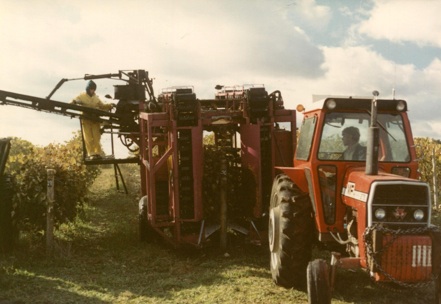
Equipment
Harvesting
Picker may be quicker but some want human touch
October 16, 2009 By The Canadian Press
 October
October
15, 2009, Lodi, CA – Roaring up and down the rows of ripe Pinot Grigio grapes,
the mechanical picker is a model of efficiency on a bright harvest day.
October
15, 2009, Lodi, CA – Roaring up and down the rows of ripe Pinot Grigio grapes,
the mechanical picker is a model of efficiency on a bright harvest day.
Slim
rods grip the vines and shake vigorously, sending grapes tumbling into the
machine’s maw. Conveyor belts carry the grapes up to fans that blow out leaves
and other debris before a metal arm shoots the grapes into a large bin trailing
alongside.
 |
|
The
machine moves on, leaving denuded vines quivering in its wake.
Once,
all California grapes destined for wine were handpicked. But during the last 30
years, more hectares have gone to machines as the size of the crop has grown
and the technology behind mechanical harvesters has improved.
“You
can do a better job and you don’t have to use a lot of people,” says Rodrigo
Sandoval, a vineyard manager for Bronco Wine Co. who supervised the phalanx of
machines picking Pinot Grigio in California’s Central Valley as the 2009
harvest got into full swing.
How
fast can a mechanical harvester pick? Very.
Bronco
co-founder Fred Franzia estimates five people working with mechanical
harvesters can do the work of about 100 people picking by hand.
It
would take 5,000 people to bring in Bronco’s large harvest – they produce a
number of brands, including Charles Shaw, known as Two Buck Chuck for its $1.99
price in California – something that’s just not practical.
“We
couldn’t physically manage a workforce that large in the amount of time needed
to get the ripe grapes into the winery,” he said.
But
for some premium wineries, handpicking remains the method of choice, says Pat
Garvey, who uses handpicking crews on 260 hectares of grapes.
Garvey
estimates it runs about $250 to $400 for 0.4 hectare (one acre) to use a mechanical
harvester, and $750 for handpicking.
But
for more expensive wines, the price difference isn’t such a big thing – and
high-end wineries generally prefer handpicking because they believe the pickers
can do a better and more selective job.
Beyond
that, a big, rowdy machine doesn’t really fit the image of a handcrafted,
artisan product.
“When
you have boutique wineries, you also have boutique prices. In many cases that
boutique winery doesn’t want machine-picking,” says Garvey, a proprietor of
Flora Springs Winery & Vineyards.
Another
thing he likes about hand-picking – he can employ people nearly year-round
(with pruning and other work), boosting morale.
Which
method is superior depends on whom you ask.
On
hilly terrain, handpicking may be easier. But in general, machine technology
has improved over the years and some argue mechanical harvesting does less
damage to grapes than cutting the clusters by hand and running them through a
destemmer/crusher.
Others
disagree.
“Handpicking
is definitely a more gentle process,” says Keith Hock, winemaker at Schramsberg
Vineyards, a Napa Valley sparkling wine producer. “We handpick the fruit
because we don’t want the berries or the clusters crushed before they get to
the winery.”
Lumbering
and loud, mechanical harvesters may be short on romance. But, for Franzia there
is grace in the way skilled machine operators can coast up and down the vines,
tractor-driven fruit bins chugging alongside in perfect synchronization.
“It’s
like music,” he says.
Print this page